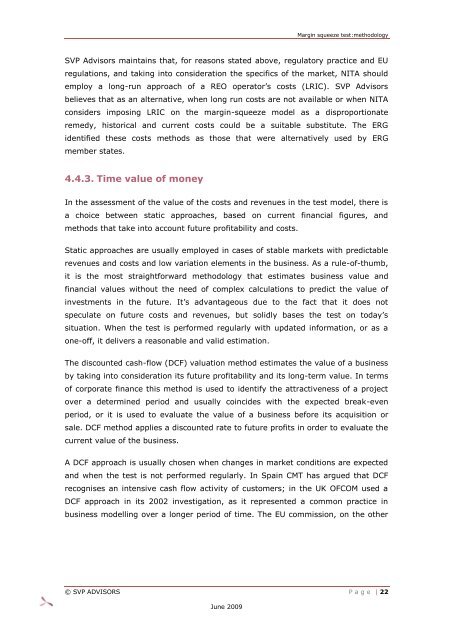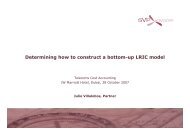ante Margin Squeeze Test
ante Margin Squeeze Test
ante Margin Squeeze Test
Create successful ePaper yourself
Turn your PDF publications into a flip-book with our unique Google optimized e-Paper software.
<strong>Margin</strong> squeeze test:methodology<br />
SVP Advisors maintains that, for reasons stated above, regulatory practice and EU<br />
regulations, and taking into consideration the specifics of the market, NITA should<br />
employ a long-run approach of a REO operator‟s costs (LRIC). SVP Advisors<br />
believes that as an alternative, when long run costs are not available or when NITA<br />
considers imposing LRIC on the margin-squeeze model as a disproportionate<br />
remedy, historical and current costs could be a suitable substitute. The ERG<br />
identified these costs methods as those that were alternatively used by ERG<br />
member states.<br />
4.4.3. Time value of money<br />
In the assessment of the value of the costs and revenues in the test model, there is<br />
a choice between static approaches, based on current financial figures, and<br />
methods that take into account future profitability and costs.<br />
Static approaches are usually employed in cases of stable markets with predictable<br />
revenues and costs and low variation elements in the business. As a rule-of-thumb,<br />
it is the most straightforward methodology that estimates business value and<br />
financial values without the need of complex calculations to predict the value of<br />
investments in the future. It‟s advantageous due to the fact that it does not<br />
speculate on future costs and revenues, but solidly bases the test on today‟s<br />
situation. When the test is performed regularly with updated information, or as a<br />
one-off, it delivers a reasonable and valid estimation.<br />
The discounted cash-flow (DCF) valuation method estimates the value of a business<br />
by taking into consideration its future profitability and its long-term value. In terms<br />
of corporate finance this method is used to identify the attractiveness of a project<br />
over a determined period and usually coincides with the expected break-even<br />
period, or it is used to evaluate the value of a business before its acquisition or<br />
sale. DCF method applies a discounted rate to future profits in order to evaluate the<br />
current value of the business.<br />
A DCF approach is usually chosen when changes in market conditions are expected<br />
and when the test is not performed regularly. In Spain CMT has argued that DCF<br />
recognises an intensive cash flow activity of customers; in the UK OFCOM used a<br />
DCF approach in its 2002 investigation, as it represented a common practice in<br />
business modelling over a longer period of time. The EU commission, on the other<br />
© SVP ADVISORS P a g e | 22<br />
June 2009



